Journal of Gynecological Research and Obstetrics
Incidence of Cesarian in Cities that Integrate the 20th Regional Health Coordination of Ceará, in the Period of 2008-2018
Luís Pereira-de-Morais1*, Cicero Pedro da Silva Júnior2, Anderson Rennan Pereira Muniz Pinheiro3, Andressa de Alencar Silva4 and Rachel de Sá Barreto Luna Callou Cruz5
2Biological Sciences Students, Regional University of Cariri, URCA, Crato, CE, Brazil
3Specialist in Collective Health from the Regional University of Cariri, URCA, Crato, CE, Brazil
4PhD student in Physiological Sciences, State University of Ceará, UECE, Fortaleza, CE, Brazil
5PhD in Maternal and Child Health from the Instituto de Medicina Integral Professor Fernando Figueira-IMIP; Adjunct Teacher at the Regional University of Cariri-URCA; Member of the Research and Extension Group on Child and Adolescent Health, GRUPECA. Crato, CE, Brazil
Cite this as
De Morais LP, Da Silva Júnior CP, Pereira Muniz Pinheiro AR, Alencar Silva AD, Luna Callou Cruz RDS (2020) Incidence of Cesarian in Cities that Integrate the 20th Regional Health Coordination of Ceará, in the Period of 2008-2018. J Gynecol Res Obstet 6(2): 031-033. DOI: 10.17352/jgro.000082Brazil is among the leaders in the ranking of the number of elective cesarean sections, and such a procedure, when unnecessary, can have serious consequences for the health of the mother and the newborn, which is generally not cleared up satisfactorily to the pregnant woman before the procedure. This study aimed to verify the incidence of cesarean sections in cities that integrate the 20th Regional Health Coordination of Ceará (RHCC), in the period of 2008-2018. This is a descriptive and retrospective study, with a quantitative approach, using data from the Hospital Information System of the Unified Health System (HIS/ SUS) of the SUS IT Department (DATASUS). This study demonstrated an increase in the number of cesarean sections in the cities of the 20th RHCC, and sometimes exceeding the number of vaginal deliveries. It is necessary to overcome the medicalization of childbirth, facilitate women’s access to health services and encourage the strengthening of educational activities, especially in primary care services, in order to encourage pregnant women to choose vaginal delivery.
Introduction
The childbirth assistance model in Brazil [1], is characterized by an excess of interventions, which has contributed to the increase in cesarean sections and maternal morbidity and mortality, and it is also observed that this is a worldwide trend [2,3]. Brazil is among the leaders in the ranking of the number of elective cesarean sections, which, as mentioned, can have serious consequences for the health of the mother and the newborn, which is generally not satisfactorily explained to the pregnant woman before the procedure [1,4].
Brazilian cesarean rates have grown from 32% in 1994, to 38% in 2000, 46.5% in 2007 and reaching 57% in 2014. Of these results about 88% are performed in the private health system, numbers well above the limit maximum of 15% proposed by the World Health Organization - WHO [5]. More recently, based on a country-specific assessment, WHO adjusted this reference rate for Brazil from 25 to 30% [6,7], which is still lower than the current scenario. The delimitation of these values is based on the identification of the association between higher rates of maternal and neonatal mortality with high rates of cesarean section [8].
As a result of the high incidence of cesarean sections in the country, several institutions - Ministry of Health, National Supplementary Health Agency (ANS) and Federal Council of Medicine (CFM) have decreed in recent years changes in the Brazilian obstetric system [9-11] .
This study aimed to verify the incidence of cesarean sections in cities that integrate the 20th Regional Health Coordination of Ceará (RHCC), in the period of 2008-2018.
Methodology
This is a descriptive and retrospective study, with a quantitative approach, carried out based on secondary data of the types of childbirth performed, notified by the Live Births Information Systems (LBIS) of the Ministry of Health, available online and free of charge by the Informatics Department of the Unified Health System (DATASUS), in five cities assigned to the 20th RHCC (Araripe, Campos Sales, Crato, Farias Brito and Várzea Alegre), over an interval of ten years.
The data survey was carried out in April 2019. Cities that didn’t have the structure to perform the cesarean section were excluded, given the nature of this investigation. The data were tabulated using the TABNET program, which were then exported to EXCEL version 2010 for Windows®, the program in which the descriptive analysis was performed.
This study was not submitted to ethical review, considering that it used data from a public domain platform. However, it is noteworthy that during the research, aspects contained in Resolution 466/12 of the National Health Council, which regulates research involving human beings, were observed.
Results
The LBIS database registered 51,953 births in the cities studied, from 2008 to 2018. Of these, 31,889 came from cesarian section.
It was observed that the rate of cesarean section increased, even exceeding the number of vaginal deliveries in some municipalities. In Araripe, vaginal delivery rates remained higher than cesarean deliveries, however, these data need to be carefully evaluated in view of the possibility of failure in notifications, since in the period from 2011 to 2015, only information regarding normal deliveries was found. In Campos Sales and Farias Brito, in the last three years, surgical deliveries were predominant. The city of Várzea Alegre, despite showing an increase in cesarean sections, in none of the ten years exceeded the number of normal births (Figure 1). The most worrying information is related to Crato, which had a cesarean section incidence above the values of normal births, being above 60% in the last eight years studied. This fact can perhaps be explained by the fact that this city is the only one among the five that have a reference maternity for high-risk births, receiving parturients from neighboring cities.
It is understood that in order to analyze more deeply and more clearly the rates of cesarean sections, it would be necessary to understand the specific reality of the different health establishments (their capacity and resources), the obstetric characteristics of the women attended, the clinical conduct protocols used [12]. There is also a consensus that the use of the Robson classification system is essential as a global standard for assessing and comparing these rates [13]. However, these discussions go beyond the limits proposed in this study.
Conclusion
Given the above, there is an increase in the number of cesarean deliveries in these cities, sometimes exceeding the number of vaginal deliveries. It is necessary to overcome the medicalization of childbirth, facilitate women’s access to health services and encourage the strengthening of educational actions, especially in primary care services, in order to motivate and encourage pregnant women to opt for vaginal delivery.
- Nakamura-Pereira M, do Carmo Leal M, Esteves-Pereira AP, Domingues RM, Torres JA, et al. (2016) Use of Robson classification to assess cesarean section rate in Brazil: the role of source of payment for childbirth. Reprod Health 13: 128. Link: https://bit.ly/3c6VwBG
- Briozzo L, Tomasso G, Colistro V (2019) Análisis de la vía del parto en los diferentes escenarios asistenciales en Uruguay. Rev Méd Urug 35: 4-31. Link: https://bit.ly/2W5koE9
- Li HT, Hellerstein S, Zhou YB, Liu JM, Blustein J (2020) Trends in Cesarean Delivery Rates in China, 2008-2018. JAMA 323: 89-91. Link: https://bit.ly/3df8jlw
- Koettker JG, Bruggemann OM, Freita PF, Riesco MLG, Costa R (2018) Obstetric practices in planned home births assisted in Brazil. Rev esc enferm 52: e 03371. Link: https://bit.ly/3b94Raw
- World Health Organization (2015) WHO statement on caesarean section rates. 8. Link: https://bit.ly/2xAJP74
- Frasão G (2016) Ministério lança protocolo com diretrizes para parto cesariana. Portal da Saúde, Ministério da Saúde. Disponível em. Link: https://bit.ly/2W6Ijmy
- Betran AP, Torloni MR, Zhang J, Ye J, Mikolajczyk R, et al. (2015) What is the optimal rate of caesarean section at population level? A systematic review of ecologic studies. Reprod Health12: 1-10. Link: https://bit.ly/2ywscG5
- Picheth SF, Crubellate JM, Verdu FC (2018) A transnacionalização do parto normal no Brasil: um estudo das últimas cinco décadas. História, Ciências, Saúde-Manguinhos 25: 1063-1082. Link: https://bit.ly/2ywFa6H
- Brasil. Presidência da República (2016) Resolução normativa 398. Disponível em. Link: https://bit.ly/3dmgtst
- Brasil. Presidência da República (2015) Resolução normativa 368 Disponível em. Link: https://bit.ly/2YAu1fP
- Leal MC (2018) Parto e nascimento no Brasil: um cenário em processo de mudança. Cad. Saúde Pública 34: e00063818. Link: https://bit.ly/2W8eCSg
- Clode N (2017) A classificação de Robson: Apenas uma forma de classificar cesarianas?. Acta Obstétrica e Ginecológica Portuguesa 11: 80-82. Link: https://bit.ly/2Lae3Rr
- Robson MS (2001) Can we reduce the caesarean section rate?. Best Pract Res Clin Obstet Gynaecol 15: 179-194. Link: https://bit.ly/3bbnECa
Article Alerts
Subscribe to our articles alerts and stay tuned.
 This work is licensed under a Creative Commons Attribution 4.0 International License.
This work is licensed under a Creative Commons Attribution 4.0 International License.


 Save to Mendeley
Save to Mendeley
